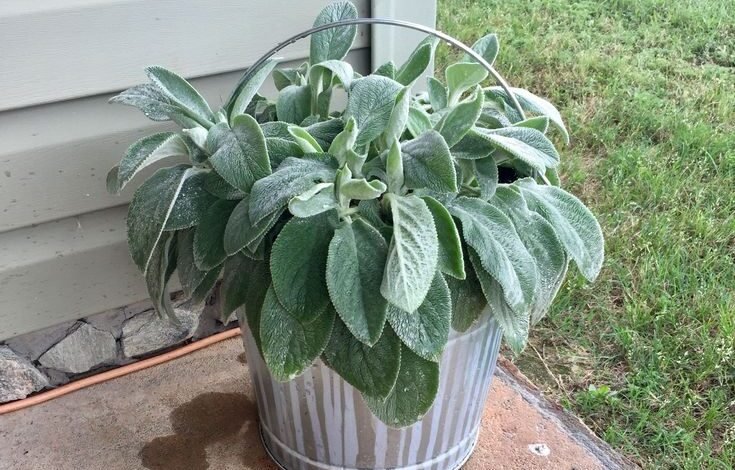Lamb’s Ear Plant: A Soft and Versatile Garden Favorite
Lamb's Ear Plant: A Soft and Versatile Garden Favorite

Introduction to the Lamb’s Ear Plant
Soft, fuzzy, and incredibly versatile, the lamb’s ear plant (Stachys byzantina) has more to offer than just its charming looks. Originally native to the Middle East and parts of Asia, lamb’s ear has been cherished for centuries for its medicinal and ornamental value. Its velvety leaves, reminiscent of a lamb’s ear, have made it a favorite among gardeners and herbal remedy enthusiasts alike.
Beyond its aesthetic appeal as a garden feature or ground cover, lamb’s ear has a rich history of being used in traditional medicine—both for its antimicrobial properties and its ability to soothe wounds. Today, this humble plant is making a comeback, especially for those seeking natural alternatives in health and wellness.
Curious about what makes the lamb’s ear plant so special? Read on as we explore its health benefits, practical uses, and how you can grow it at home to make the most of its incredible properties!
Health Benefits of the Lamb’s Ear Plant
More than just a pretty plant, lamb’s ear boasts a number of health benefits, earning its spot as a staple in many natural first-aid kits. Here’s how this plant can support wellness:
1. Antibacterial Properties
Lamb’s ear leaves contain natural antibacterial compounds that can help prevent infections. Historically, the leaves were used as makeshift bandages to cover wounds, particularly during wars when traditional medical supplies were scarce. These antibacterial properties provide a natural way to protect cuts or abrasions from harmful bacteria.
2. Anti-inflammatory Effects
Thanks to its anti-inflammatory compounds, lamb’s ear has been employed to soothe irritated or swollen skin. This makes it a great plant to explore for those suffering from mild skin irritation or inflammation issues due to bites, scratches, or even conditions like eczema.
3. Wound Healing Support
The soft, absorbent texture of lamb’s ear leaves has made them popular as a natural wound dressing throughout history. The leaves not only protect injuries from dirt and germs but also promote faster healing thanks to their antimicrobial and soothing qualities.
4. Herbal Remedy for Stings and Rashes
Lamb’s ear leaves can also be used to calm rashes, insect bites, or stings. Simply crushing and rubbing the leaves gently on the affected area can provide relief, while the plant’s natural compounds work to reduce irritation.
From minor scratches to skin discomforts, lamb’s ear continues to show its versatility as a natural solution for everyday ailments.
How to Grow and Care for Lamb’s Ear at Home
Whether you’re an experienced gardener or someone with a budding interest in natural remedies, growing lamb’s ear at home is a rewarding and manageable project. Here’s a quick guide to help your lamb’s ear thrive.
1. Choose the Right Location
Lamb’s ear loves sunlight! While it tolerates partial shade, it thrives best in full sun. When choosing a spot, ensure the area has good drainage—this plant dislikes overly wet soils.
2. Soil and Watering Needs
Well-draining soil is key for lamb’s ear. A slightly sandy or loamy soil mix works beautifully. When it comes to watering, lamb’s ear is drought-tolerant, so infrequent yet deep watering is ideal. Allow the soil to dry out completely between waterings to prevent root rot.
3. Handling Frost and Hot Climates
Lamb’s ear is a hardy perennial, capable of handling low temperatures. However, it’s recommended to mulch around the plant during colder months to protect its roots. Similarly, in extremely hot climates, be sure to provide some afternoon shade to prevent its leaves from scorching.
4. Pruning and Maintenance
To keep your lamb’s ear looking its best, trim back older, yellowing leaves, especially after its flowering period, which occurs in late spring or early summer. You can also prune spent flowers to encourage fresh growth.
5. Propagation
Want to grow more lamb’s ear around your garden? Simply divide established plants or take cuttings and plant them in new areas. The plant propagates easily, making it a delightful addition to any natural home garden!
Practical Uses of Lamb’s Ear in Everyday Life
The usefulness of lamb’s ear extends far beyond gardening and health care—it also lends itself to a wide range of creative applications in daily life.
1. Natural Skincare Helper
Given its soothing and anti-inflammatory properties, lamb’s ear can make its way into your skincare rituals. Use its leaves as a natural compress to calm skin irritations or minor inflammation. While not a replacement for professional skincare products, it makes a great complementary remedy.
2. First-Aid Staple
Keep lamb’s ear in your natural first-aid kit. Its antibacterial properties make its leaves useful for emergency wound care or covering small cuts and scrapes when bandages aren’t on hand. Simply rinse a fresh leaf and place it on the wound for a natural dressing.
3. Decorative Touch
With its velvety texture and soft silver-green hue, lamb’s ear is a treasure for crafters and home decorators. Create unique wreaths, rustic table arrangements, or even use the leaves as a soft accent in flower bouquets. Its calming green tones add subtle charm to any decor style.
4. Tea and Infusions
While not as well-known as other herbal teas, lamb’s ear can be used to brew a mild tea that’s thought to offer relaxation and immune support. Simply steep freshly washed leaves in hot water, strain, and enjoy. (Always consult a healthcare provider before incorporating new herbal teas into your routine.)
The combination of functionality and aesthetics makes lamb’s ear a plant worth celebrating, not just in the garden but in day-to-day life.
Why You Should Give Lamb’s Ear a Try
Whether you’re looking to create a natural remedy garden, add some soft greenery to your outdoor space, or explore traditional healing methods, the lamb’s ear plant has something for everyone. Its versatility and ease of care make it a good fit for homemakers, health enthusiasts, and gardeners alike.
Give it a try—get your hands dirty and start growing your own lamb’s ear. Not only will you enjoy its lovely look, but you’ll also gain access to a range of health and practical benefits.
Found this piece insightful? Share it with fellow plant enthusiasts or anyone interested in natural remedies. Your next great health ally might just be the lamb’s ear plant!



